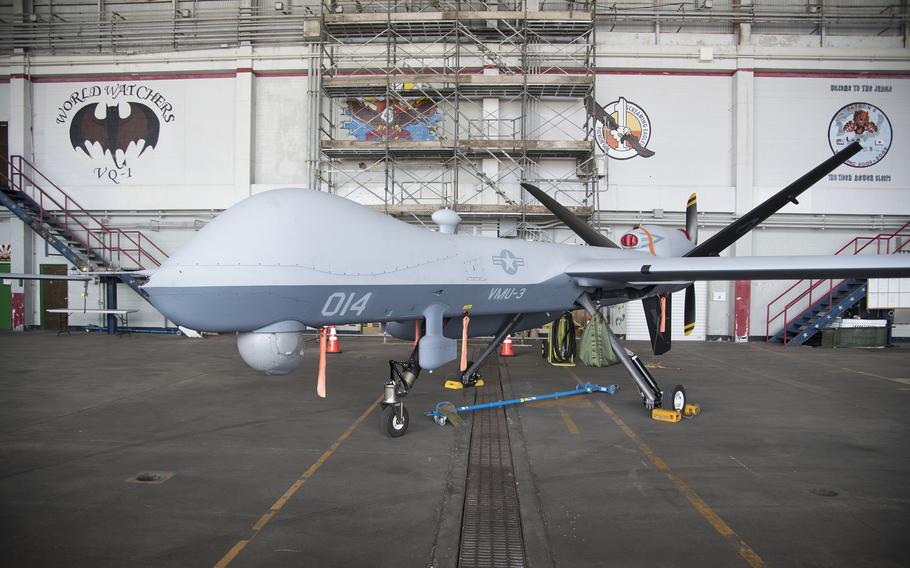Asia-Pacific
Marines extend Reaper deployment at Okinawa air base, Japanese officials say
Stars and Stripes August 28, 2025

A Marine Corps MQ-9A Reaper assigned to Marine Unmanned Aerial Vehicle Squadron 3 parks in a hangar on Kadena Air Base, Okinawa, March 21, 2025. (Keishi Koja/Stars and Stripes)
The Marine Corps plans to keep a group of MQ-9A Reaper drones on Okinawa indefinitely beyond their original yearlong deployment, according to Japan’s Ministry of Defense.
Fewer than six of the unmanned aerial vehicles arrived at Kadena Air Base on Aug. 13, 2024. They belong to Marine Unmanned Aerial Vehicle Squadron 3, Marine Aircraft Group 24, 1st Marine Aircraft Wing.
The Reapers were scheduled to stay one year while conducting intelligence, surveillance and reconnaissance activities around the Nansei region, a spokeswoman with the prefecture’s Military Base Affairs Division said at the time.
The extended stay continues an increased presence of U.S. unmanned aerial vehicles that began with Air Force Reapers in 2023 and was boosted by Navy Tritons in April. Two Tritons also operated from Kadena between May and October 2024.
The Okinawa Defense Bureau, an arm of the ministry, announced the continuing Reaper presence on its website Wednesday, citing the “increased severity of the security environment surrounding Japan.”
“Japan and the U.S. confirmed the need to further deepen their cooperation in [intelligence, surveillance and reconnaissance] activities during the ‘2+2’ meeting held in July last year,” the release said. The 2+2 meeting was a Tokyo summit by former Secretary of State Antony Blinken, former Defense Secretary Lloyd Austin and Japan’s defense and foreign affairs ministers at the time.
First Marine Aircraft Wing spokesman 2nd Lt. B.K. Rhodes confirmed the drones are still at Kadena but declined to confirm an extended deployment or disclose the exact number of aircraft. Rhodes, in an email Wednesday, cited operational security.
“This rotational deployment supports training in the region,” he said. “Operating from Japan provides VMU-3 with realistic domain awareness training that will increase proficiency to help provide critical support to Marines, the Joint Force, and our Japanese Allies in support of the defense of Japan.”
The Nansei island chain — also known as the Ryukyu Islands — stretches from Kyushu, the southernmost of Japan’s four main islands, to Taiwan.
China in recent years has been conducting more drone flights around Taiwan and near Japanese airspace. In June, its military carried out Pacific drills involving both of its aircraft carriers — the Shandong and Liaoning — for the first time.
Defense bureau officials explained the extended deployment to the prefecture during a meeting in Okinawa’s capital city, Naha, on Wednesday, a Military Base Affairs Division spokesman said by phone that day. Fewer than 20 personnel will remain deployed with the aircraft, he said.
“We told the bureau that the deadline was about one year, so we asked them to adhere to it,” the spokesman said. “We asked them to clarify how long the aircraft will be deployed.”
The Air Force and the Navy have also deployed drones to Kadena in recent years.
Air Force Reapers with the 319th Expeditionary Reconnaissance Squadron have flown intelligence, surveillance and reconnaissance missions over Japan’s southern island chain from Kadena since 2023.
An unspecified number of Navy MQ-4C Tritons deployed to Kadena in April from Andersen Air Force Base, Guam, 7th Fleet spokeswoman Lt. Cmdr. Jamie Moroney said by email at the time. The aircraft, assigned to Unmanned Patrol Squadron 19 at Naval Air Station Jacksonville, Fla., came with about 50 supporting personnel.
Tritons are primarily intelligence-gathering, reconnaissance and surveillance vehicles. They can fly for more than 24 hours at altitudes above 50,000 feet with a range of 7,400 miles, according to their maker, Northrop Grumman.
The Marines and Air Force employ the Reaper for the same mission; the Air Force highlights its ability to carry up to eight air-to-ground Hellfire missiles, according to official websites for each service.
The Tritons’ mission on Okinawa is “a long-planned temporary deployment in support of U.S. Indo-Pacific Command’s intelligence, surveillance, and reconnaissance operations and is not in response to any provocation or action,” Moroney said.
The Reaper, made by General Atomics of San Diego, is a medium-altitude, long-endurance, remotely operated aircraft used primarily for surveillance, according to the Air Force. They can carry a combination of Hellfire missiles and Paveway laser-guided bombs.